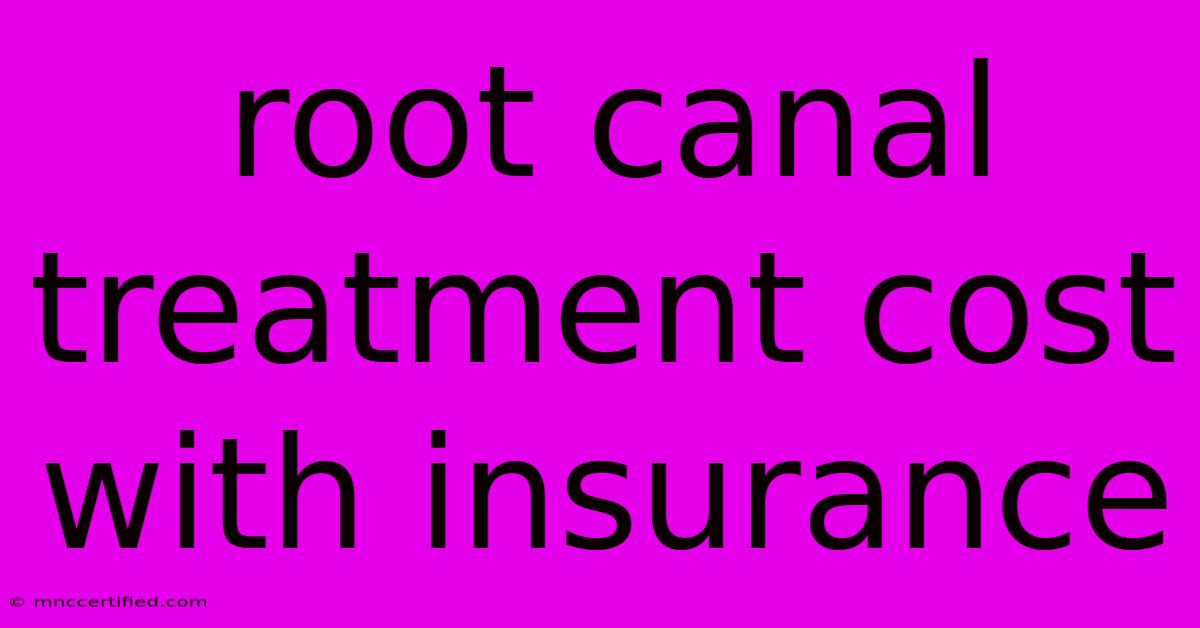Root Canal Treatment Cost With Insurance

Table of Contents
Root Canal Treatment Cost with Insurance: A Comprehensive Guide
Root canal treatment is a common dental procedure that can save your tooth from extraction. It involves removing the infected pulp, the soft tissue inside your tooth, and filling the space with a special material. While it's a highly effective treatment, it can be expensive, especially if you don't have dental insurance.
This article will guide you through the cost of root canal treatment, exploring how dental insurance can help you manage the expense.
Understanding Root Canal Treatment Costs
The cost of root canal treatment can vary depending on a few factors, including:
- Complexity of the procedure: A single-rooted tooth is generally cheaper to treat than a multi-rooted tooth.
- Location of the tooth: Teeth in the front of your mouth may require a different approach compared to teeth in the back, potentially impacting the cost.
- Your location: Dental costs can vary depending on your geographical area.
- Your dentist's fees: Different dentists may charge different rates.
Average Root Canal Treatment Costs:
While the cost can fluctuate, here are some average estimates for root canal treatment in the US:
- Single-rooted tooth: $500 - $1,000
- Multi-rooted tooth: $700 - $1,500
How Dental Insurance Impacts the Cost
Dental insurance plays a crucial role in mitigating the cost of root canal treatment. Here's how it works:
- Coverage: Most dental insurance plans cover a portion of root canal treatment, typically around 80% of the usual and customary fees.
- Deductible: You'll often have to pay a deductible before your insurance starts covering the costs.
- Co-pay: You may also be responsible for a co-pay, a fixed amount per visit.
- Annual maximum: There might be a limit on the total amount your insurance will cover per year.
Important Note: It's crucial to review your insurance policy carefully to understand your coverage and potential out-of-pocket expenses.
Managing Costs Without Insurance
If you don't have dental insurance, root canal treatment can be a significant financial burden. Here are some tips to manage the costs:
- Negotiate payment plans: Discuss flexible payment plans with your dentist.
- Look for dental financing options: Several financial institutions offer loans specifically for dental procedures.
- Explore dental discount plans: These plans can provide discounted rates on dental services, including root canal treatment.
- Consider a dental savings account (HSA): If you have a high-deductible health plan, you can use a HSA to cover eligible dental expenses.
Protecting Your Smile with Prevention
Preventing tooth decay and gum disease can significantly lower your chances of needing a root canal in the first place. Here are some key preventive measures:
- Brush your teeth twice a day: Use a fluoride toothpaste and a soft-bristled brush.
- Floss daily: This removes plaque and food particles from between your teeth.
- Visit your dentist regularly: Schedule checkups and cleanings every six months.
- Maintain a healthy diet: Avoid sugary drinks and snacks, and choose foods rich in nutrients.
Conclusion
Root canal treatment can be an effective way to save your tooth, but it's crucial to understand the associated costs. Dental insurance can significantly reduce your out-of-pocket expenses, while preventive measures can help you avoid the need for treatment in the first place.
Remember to speak to your dentist to discuss your individual circumstances and determine the most appropriate treatment plan.

Thank you for visiting our website wich cover about Root Canal Treatment Cost With Insurance. We hope the information provided has been useful to you. Feel free to contact us if you have any questions or need further assistance. See you next time and dont miss to bookmark.
Featured Posts
-
Reds Trio Could Return This Week
Nov 08, 2024
-
Chelsea Vs Noah Uefa Conference League Livestream
Nov 08, 2024
-
Commercial Insurance Colorado Springs Co
Nov 08, 2024
-
Westbrook Earns Malones Rockstar Praise
Nov 08, 2024
-
Bo E Interest Rate Cut Mortgage Outlook
Nov 08, 2024